ASRock Industrial NUC BOX-1165G7 Mini-PC Review: An Ultra-Compact Tiger Lake Desktop
by Ganesh T S on August 26, 2021 8:15 AM EST- Posted in
- Systems
- Intel
- NUC
- UCFF
- Willow Cove
- ASRock Industrial
- Tiger Lake-U
BAPCo SYSmark 25
The ASRock NUC BOX-1165G7 was evaluated using our Fall 2018 test suite for small-form factor PCs. In the first section, we will be looking at SYSmark 25.
BAPCo's SYSmark 25 is an application-based benchmark that uses real-world applications to replay usage patterns of business users in the areas of productivity, creativity, and responsiveness. The 'Productivity Scenario' covers office-centric activities including word processing, spreadsheet usage, financial analysis, software development, application installation, file compression, and e-mail management. The 'Creativity Scenario' represents media-centric activities such as digital photo processing, AI and ML for face recognition in photos and videos for the purpose of content creation, etc. The 'Responsiveness Scenario' evaluates the ability of the system to react in a quick manner to user inputs in areas such as application and file launches, web browsing, and multi-tasking.
Scores are meant to be compared against a reference desktop (the SYSmark 25 calibration system, a Lenovo Thinkcenter M720q with a Core i5-8500T and 8GB of DDR4 memory to go with a 256GB M.2 NVMe SSD). The calibration system scores 1000 in each of the scenarios. A score of, say, 2000, would imply that the system under test is twice as fast as the reference system.
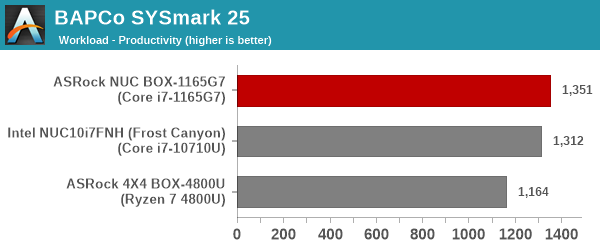
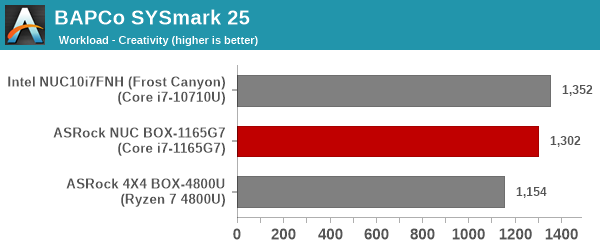
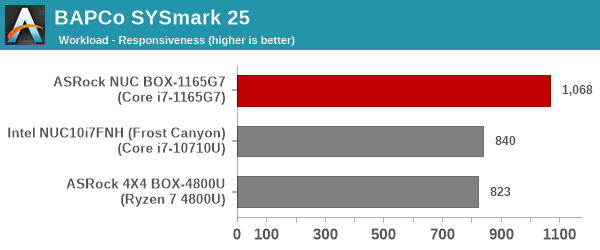
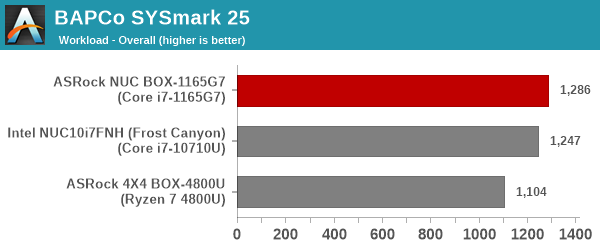
In terms of raw scores, the NUC BOX-1165G7 narrowly outperforms the Frost Canyon NUC. However, a closer look at the Creativity workload shows the benefits of having two additional cores (the Core i7-10710U is a hexa-core processor). The responsiveness metric is a huge win for the NUC BOX-1165G7, thanks to its PCIe 4.0 SSD and DDR4-3200 SODIMMs.
SYSmark 25 also adds energy measurement to the mix. A high score in the SYSmark benchmarks might be nice to have, but, potential customers also need to determine the balance between power consumption and the efficiency of the system. For example, in the average office scenario, it might not be worth purchasing a noisy and power-hungry PC just because it ends up with a 2000 score in the SYSmark 2014 SE benchmarks. In order to provide a balanced perspective, SYSmark 25 also allows vendors and decision makers to track the energy consumption during each workload. In the graphs below, we find the total energy consumed by the PC under test for a single iteration of each SYSmark 25 workload. For reference, the calibration system consumes 8.88 Wh for productivity, 10.81 Wh for creativity, and 19.69 Wh overall.
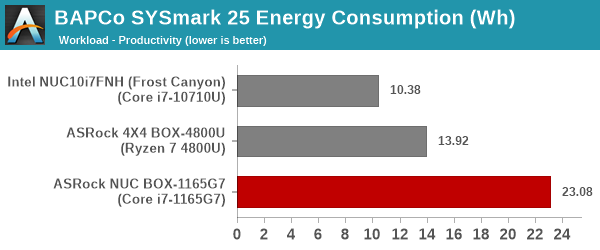

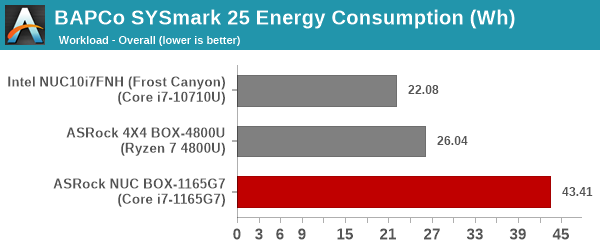
The energy numbers present a bad picture for the NUC BOX-1165G7. There are multiple components that could be responsible - 64GB of DDR-3200 DRAM compared to DDR-2666 in the Frost Canyon NUC, the presence of a PCIe 4.0 SSD compared to PCIe 3.0 SSDs in the other two systems, and general platform power. However, as we shall see further down in this review, the power consumption numbers are not that different from other mini-PCs. So, it is likely that boost clocks and other workload-specific triggers are responsible for these energy consumption numbers.










33 Comments
View All Comments
sutramassage2 - Wednesday, September 1, 2021 - link
Our flair for showcasing koramangala ingredients shines through in every one of our menus, whether you are looking for a casual lunch or dinner at sutra massage & b2b spa, or a traditional Afternoon sandwich massage. for more info visit here:- https://www.sutramassage.commode_13h - Tuesday, September 21, 2021 - link
spammerwillis936 - Thursday, August 26, 2021 - link
This is a quite nice looking product. I just wish they'd have used a latching power connector.brunosalezze - Thursday, August 26, 2021 - link
I have one of these. Its actually my work pc right now, I dont need a gpu or multiple cores to code, I and have dedicated servers avaiable to run the code. It serves me very well to be able to have 2 4k monitors and not strugle to move the mouse. My only issue with it, its when I try to hook up a gpu with a R43SG. Its very hard to boot, the issue is not the conection, I've used this connector to other mini pcs with my 6800 and always worked very well, the issue is this particular bios, I think.xsoft7 - Thursday, August 26, 2021 - link
there is a Zen3 mini PC.. with 5900HX which costs 649$ can you review it?https://store.minisforum.com/collections/all-produ...
many youtube videos are raving about it.
abufrejoval - Thursday, August 26, 2021 - link
You send them one, they'll be more likely to review it.Now seriously, you can infer quite a bit on Ryzen by looking at what has been tested already.
All these APUs are basically the same silicon operated at distinct power settings, ~15 Watts for 5800U, ~35 Watts for 5900HX and ~65 Watts for 5700G.
The Vega9 graphics don't seem to benefit a terrible lot from extra Wattage, because it's mostly bandwidth constained. There are reviews out there which demonstrate the potential with overclocker DIMMs and an overclocked GPU, but those gains remain linear from a very low baseline.
Peak clocks are just a couple hundred MHz apart, hardly enough to matter, so what you mostly get from the extra Watts is sustained clocks on higher core counts. Go take the values for 15 Watts and 65 Watts, split the difference and add ~20% because CMOS won't give linear clock returns on Watts beyond say 2GHz.
Somewhere on Youtube you'll find someone raving about any thing. But APUs aim really for the very rational, just enough to get the work done in a couple of form factors and at a few price points.
meacupla - Thursday, August 26, 2021 - link
How would a 1135G7 (28W) compare with a Ryzen 5 PRO 5650GE (35W)?There are, or were, plenty of 1L class SFF PCs using the 4650GE, and OEMs are probably transitioning to the 5650GE right now.
If you are going to use a U series APUs at higher TDP, because it's a SFF, I think you might as well include 35W desktop APUs used in SFF for comparison.
abufrejoval - Thursday, August 26, 2021 - link
I got the NUC8 (Iris 655), NUC10 (UHD) and NUC11 (Xe) all as i7, each with 64GB and 10Gbit via Sabrent TB3 (Aquantia really) NICs to operate as a oVirt(RHV) HCI cluster.Played around with Windows a bit before they became "productive".
I was really interested to see how the iGPU generations would play out and in IPC vs cores, 14nm vs. 10nm etc.
Twice the iGPU resources (48 vs 24EU) + the 128MB eDRAM on the Iris 655 only got 50% performance increase, just as the 3DMark gaming score shows. That seemed to spell trouble for the 96EU Xe, which doesn't have any of that. But it didn't. Instead the 96EU Xe scales pretty much linearly vs the 24EU UHD, but that still doesn't make it a games engine. Still a NIght Raid or WildLife type game runs just fine at FHD on the NUC11.
In terms of CPU benchmarks, it was a clear win for the NUC11. It got awfully close to my 5800X on single core benchmarks, especially on Linux, while the 6-Core 10700U could not gain ground against the 4-Core 1065G7 on e.g. Blender or anything thready.
I also have a Lenovo 5800U notebook, which can be configured for the 28Watt and 15Watt energy consumption levels (which is sticks to, religiously!) and it really can't gain much ground on thready workloads against the 1065G7, either, when that is configured to those same 15 and 28 Watt limits. I only measured via HWinfo, not at the wall, so there is that.
What I really like about the NUCs is that they allow very precise control over P1, P2, TAU and the fans (I need absolute control over maximum noise and want max CPU for that in operation). They give you that, while the generation over generation looks of that BIOS are so different, it seams to be completely different teams.
Ah and yeah, the Xe graphics do outperform the Vega9 on the 5800U significantly in numbers, while it doesn't really matter for gaming. Both are super smooth with Google Maps in 3D mode on Chromium in Windows at 4k. But any software less optimized will struggle beyond 2D.
Multi-Monitor support on all the Intel iGPUs is excellent on Windows and Linux, the Vega9 has serious issues switching between external and internal graphics even on Windows. A dual alt-mode USB-C adapter which supports a 4k primary and a FHD secondary seamlessly on any Intel iGPU with very OS I've tested works as you'd expect it, but with the Radeon drivers (both Lenovo and latest AMD) just switching between the 3k laptop screen and the external 4k primary freezes the output to the point where only a hard poweroff will bring it back.
With all systems playing with the power settings (15-64Watts for the NUCs, 12-28Watts for 5800U), those settings did little to nothing for the iGPU. It's really just all about how much left-over budget goes to enable higher CPU clocks (until thermals kick in).
zsdersw - Friday, August 27, 2021 - link
What exactly is "industrial" about it? If it's not fanless it can't really be considered industrial and it's just another NUC-type computer.abufrejoval - Friday, August 27, 2021 - link
The marketing channel.They don't metion any testing specification in the technical data on the ASrock web site.
Without that it may just mean that consumer (fool protection) return rights might not apply.